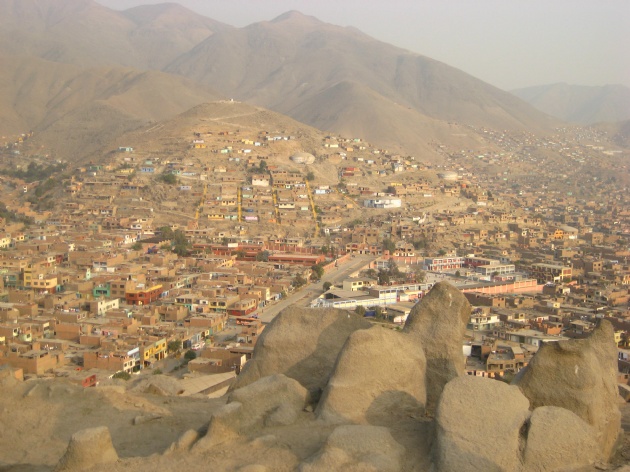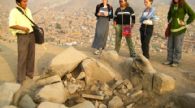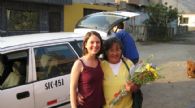Five years after her first contact with people from a developing
country, Diana Moldoveanu recounts how a self-interested adventure of discovery
was transformed into an invaluable opportunity for assisting others.
As a small
child in her native Romania, Diana often spent long hours contemplating the
terrestrial globe that reigned in her grandparent’s living room. “It fueled my
curiosity about other places in general. I thought; what is the Nile, the
Amazon? What can we find elsewhere?"
It was in a
Peruvian población in 2007 that she
found the answer. "Elsewhere,” she said, “there are people with incredible
personalities and skills who persevere in their learning and development in
spite of unimaginable difficulties. Their determination inspired me to assist
them in any way I could.’’
The young
woman was not, however, destined for a career in international cooperation.
After her arrival in Quebec at the age of 15, she obtained a degree in
biochemistry at the University of Montreal, but realized that science could not
offer the opportunities she hoped for. She then left Montreal and a loving
boyfriend to undertake an environmental degree at Sherbrooke.
"I
finished my undergraduate studies with the determination to selfishly do
something I loved, and had no clue where to start. I remember saying; all
right, I love nature, languages, discovering places and cultures, and I want to
engage in passionate creation. There was no clear notion of altruism,
volunteering or anything of the sort, but when I set out to look for
opportunities I discovered that I enjoyed engaging with others. In September
2006, I started a graduate program in environment that allowed me to combine
everything.’’
That
included two semesters at Sherbrooke, an internship and a semester in Latin
America. ‘’It convinced me,” said Diana.
Together
with other interns, she embarked on a plane to Lima, where they would
contribute to an environmental project. Most importantly, they would share
daily life with local families, which proved a source of invaluable insight
into social issues faced by developing countries.
"I did
not know what to expect, and I agonized a bit. Then I clung to the idea that it
was going to be like in Romania. And indeed, when I first exited the airport, I
had the impression of being in Bucharest; the air smelled of car exhaust!’’,
she said jokingly.
After three days of leisure in the Peruvian
capital, Diana and her friends travelled to Collique, a shantytown tucked in a
valley flanked by two steep, rocky hillsides and located in the Comas district,
Lima. "I'd never seen people live in such conditions and that’s when I had
a real shock - I was worried about my safety", she says in a serious tone.
In the end, she had nothing to fear.
Collique
was started by rural migrants, who built their homes with what they had on hand
when they arrived in Lima in the ’50s. Migrant families were typically very
poor, not necessarily because they had always been so, but because when they
moved from a native village of thousands to a colonial city of millions, they
faced a completely different system; whatever served them before – tools,
knowledge, connections – suddenly became obsolete. With no cash or access to
income, little friends or family, and the disadvantage of their native lineage,
they were forced to occupy land illegally and just build from there.
Today, new
families continue to arrive in Collique. Their fate is very similar to the
initial migrants’, since economic activity offers reduced options for
employment. Men work in the transportation system or workshops, while women
usually travel to Lima where they are employed as domestic workers.
Diana adds;
"I had a preconceived idea of life in the favelas because I was not aware of their history. I believed in the
too-popular idea that people were lazy and basically deserving of their lot.
Instead, I discovered extremely dynamic, satisfied and hopeful individuals
organized in a network of support displaying breathtaking creativity to develop
self-reliance; women and youth groups, mother’s clubs, popular soup canteens,
community centers and radio stations. They even had an archaeology museum run
by a local aficionado!’’
‘’However’’,
she adds, “while leaders helped build homes, roads and schools, their children
didn’t seem to fare so well. I was flabbergasted by high-school drop-out rates
that, somewhere near 60<>percentage<>, flirted with obscenity! No wonder, I thought, the
kids have little chance to exercise their talents in the workplace.’’
Diana
came to understand that most teenagers dropped out because they thought they
had no chance to pass the university entrance exam. Moreover, at around age 12,
acutely aware of poverty, they chose to work for a few dollars a day. Yet
another subtle element that lead them to abandonment, recounts Diana, was the
absence of university-educated family members.
‘’The
more I spoke with the young people of Collique, the more their struggle became
clear to me. I saw a burning desire for learning and affirmation and a scarcity
of appropriate opportunities. The young were a little distressed because,
unlike previous generations, they had an expectation for social mobility during
their own lifetimes.’’
Everything
came together one evening, as Diana was having supper with her Peruvian father;
a man of 55, whose promise was to build a sports center for the young. Julio worked relentlessly 6 days a week from
5 am to 10 pm and then woke up on Sunday mornings – every Sunday morning - to
mobilize support for the sports center.
‘’I
understood right away that I needed to find a manner to assist such leaders in
building opportunities for their children. This is when I started thinking
about becoming the kind of person people would trust with their hopes and
dreams.’’

 In The Latest Issue:Latest Issue:
In The Latest Issue:Latest Issue:
- A Bittersweet Farewell
- The new Laval Aquatic Co...
- The End of an Era:
Articles
Calendar
Virtual- ANNUAL TEACHER APPRECIATION CONTEST
- APPUI LAVAL
- ARTS & CULTURE
- CAMPS
- CAR GUIDE
- CCIL
- CENTENNIAL ACADEMY
- CHARITY FUNDRAISING
- CITYTV
- COSMODÔME
- COMMUNITY CONNECTIONS
- COVER STORY
- DINA DIMITRATOS
- ÉCOLE SUPÉRIEURE DE BALLET DU QUÉBEC
- EDITORIALS
- ÉDUCALOI
- EDUCATION
- EMPLOYMENT & ENTREPRENEURSHIP
- FÊTE DE LA FAMILLE
- FÊTE DU QUARTIER SAINT-BRUNO
- FAMILIES
- FESTIVAL LAVAL LAUGHS
- FÊTE DE QUARTIER VAL-DES-BRISES
- FINANCES
- GLI CUMBARE
- GROUPE RENO-EXPERT
- HEALTH & WELL-BEING
- 30 MINUTE HIT
- ANXIETY
- CHILDREN`S HEALTH & WELLNESS
- CLOSE AID
- DENTAL WELLNESS
- EXTREME EVOLUTION SPORTS CENTRE
- FONDATION CITÉ DE LA SANTÉ
- GENERAL
- HEARING HEALTH
- MESSAGES FROM THE HEALTH AGENCY OF CANADA
- MENTAL HEALTH
- SEXUALITY
- SOCIAL INTEGRATION
- SPECIAL NEEDS
- TEENS
- THE NUTRITION CORNER
- THE NUTRITION CORNER - RECIPES
- VACATION DESTINATION
- WOMEN'S FITNESS
- WOMEN'S HEALTH
- HILTON MONTREAL/LAVAL
- HOME & GARDEN
- INTERNATIONAL WOMEN'S DAY
- JAGUAR LAVAL
- LAVAL À VÉLO
- LAVAL FAMILIES TV SHOW
- LAVAL FAMILIES MAGAZINE CARES
- LAVAL URBAN IN NATURE
- LE PARCOURS DES HÉROS
- LES PETITS GOURMETS DANS MA COUR
- LEON'S FURNITURE
- LEONARDO DA VINCI CENTRE
- LFM PREMIERES
- LIFE BALANCE
- M.P. PROFILE
- MISS EDGAR'S AND MISS CRAMP'S SCHOOL
- MISSING CHILDREN'S NETWORK
- NETFOLIE
- NORTH STAR ACADEMY LAVAL
- OUTFRONT MEDIA
- PASSION SOCCER
- PARC DE LA RIVIÈRE-DES-MILLE-ÎLES
- PÂTISSERIE ST-MARTIN
- PIZZERIA LÌOLÀ
- PLACE BELL
- PORTRAITS OF YOUR MNA'S
- ROCKET DE LAVAL
- SACRED HEART SCHOOL
- SCOTIA BANK
- SHERATON LAVAL HOTEL
- SOCIÉTÉ ALZHEIMER LAVAL
- STATION 55
- STL
- SUBARU DE LAVAL
- TECHNOLOGY
- TEDXLAVAL
- TODAY`S LAURENTIANS AND LANAUDIÈRE
- TODAY`S LAVAL
- WARNER MUSIC
- THIS ISSUE
- MOST RECENT
Magazine
Finding One’s Own Path in the Poblaciones of Peru – Part I
Diana Moldoveanu from Laval recounts how a self-interested adventure of discovery was transformed into an invaluable opportunity for assisting others.
Articles ~e 105,7 Rythme FM 4 chemins Annual Teacher Appreciation Contest Appui Laval Arts & Culture Ballet Eddy Toussaint Camps THIS ISSUE MORE...
CONTESTS Enter our contests
CONTESTS Enter our contests
CALENDAR
Events & Activities
COMMUNITY Posts Events
PUBLICATIONS Our Magazine Family Resource Directory
LFM BUSINESS NETWORK Learn more
COUPONS Click to save!
COMMUNITY Posts Events
PUBLICATIONS Our Magazine Family Resource Directory
LFM BUSINESS NETWORK Learn more
COUPONS Click to save!
SUBSCRIPTIONS
Subscribe to the magazine
Un-Subscribe
E-NEWSLETTER Subscribe to our E-newsletter Un-Subscribe
WRITE FOR US Guidelines & Submissions
POLLS Vote today!
E-NEWSLETTER Subscribe to our E-newsletter Un-Subscribe
WRITE FOR US Guidelines & Submissions
POLLS Vote today!
ADVERTISERS
How to & Media guide
Pay your LFM invoice
SUGGESTIONS Reader's Survey Suggest a Listing
LFM About Us Our Mission Giving Back Contact Us
SUGGESTIONS Reader's Survey Suggest a Listing
LFM About Us Our Mission Giving Back Contact Us
 PICK-UP LOCATIONS
Get a copy of LFM!
PICK-UP LOCATIONS
Get a copy of LFM!
TERMS & CONDITIONS Privacy | Terms
ISSN (ONLINE) 2291-1677
ISSN (PRINT) 2291-1677
Website by ZENxDESIGN





 BY:
BY: 
Tweet
Share